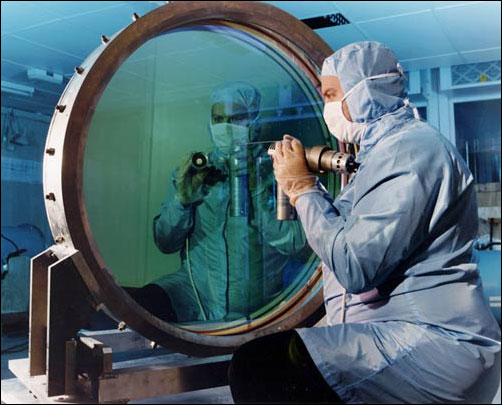Planets pave the way for clean energy
A group of international scientists headed by Oxford University have ' looked ' at the dense and hot masses of the planets, thus gaining a deeper understanding of controlled thermonuclear reactions. . The entire work is published in the journal Nature Physics.
Insights into the planets help researchers better understand nuclear energy - the kind of energy that is considered to be the energy of the future. It is a very attractive, clean energy source for the environment, the main material is endless seawater, does not cause greenhouse effect and does not produce long-lived radioactive waste.
Using the Vulcan laser device (made by Oxford University Scientific Equipment Center), the team used a very powerful beam of X-rays to reproduce the conditions that occur in the planet's core, where substances snakes have temperatures above 50,000 degrees. Knowledge of the complex state of matter in extreme conditions is one of the biggest problems of modern physics.

Part of Vulcan machine (Photo: physorg.com)
The experiments on Vulcan aim to better understand the two planets model, Jupiter (Jupiter) and Saturn (Saturn), as well as adding knowledge about the composition and age of other planets in the solar system. .
The inelastic X-ray diffusion method on the compression sample of lithium has proved that it is possible to predict the dense matter state, temperature and its structural properties. The thermodynamic, temperature, density and ionizing properties are all measured by combining high-precision, non-invasive X-ray detection with advanced methods. other advance.
The experiment found that the central matter of the planets is an intermediate state between solids and liquids at distances greater than 0.3 nanometers.
Imagine a small nanometer of 1 part of a strand of hair. The results show that the materials in these conditions ' behave ' as an electrically charged liquid but at smaller distances are like a gas.
Dr. Gianluca Gregori, Oxford University and Center for Laser Devices said: Researching the states of matter, this time experimenting on lithium, shows the practical application of controlled fusion synthesis and provides knowledge related to the astrophysical environment at the center of planets and shells of old stars . Therefore, not only research helps us to more accurately model kinetic models of the planets, but also expand the understanding of controlled fusion synthesis, where matter only in liquid and gaseous form to overcome to initiate fusion reactions.
This work provides us with more insights into the complex systems of particles, which are subject to the manipulation of both motion and classical mechanics and quantum mechanics.
Professor Mike Dunne, Director of the Center for Laser Devices said: ' Using high-power lasers can find solutions to astrophysical problems, an area of interest.
We are happy that the laser device has contributed to this research. The use of powerful lasers has become an effective approach to finding a long-term solution to a clean, non-carbon-based energy source . '
- Successful development of clean energy
- Vietnam won the Global Energy Award
- The world needs to accelerate the application of clean energy
- Energy Observer - 'Laboratory' of floating energy throughout the world
- The most surreal alternative energy sources in human history
- Denmark is at the forefront of producing clean energy
- Renewable energy is enough to provide 1/4 of the world's electricity demand
- China is at the forefront of clean energy use
- Clean energy future for Cuba
- Anglo-American cooperates to exploit huge amounts of energy from lasers
- Clean energy sources are far outstripping coal
- Plant-derived technology will be the solution to a clean energy problem
 Van Allen's belt and evidence that the Apollo 11 mission to the Moon was myth
Van Allen's belt and evidence that the Apollo 11 mission to the Moon was myth The levels of civilization in the universe (Kardashev scale)
The levels of civilization in the universe (Kardashev scale) Today Mars, the sun and the Earth are aligned
Today Mars, the sun and the Earth are aligned The Amazon owner announced a secret plan to build a space base for thousands of people
The Amazon owner announced a secret plan to build a space base for thousands of people